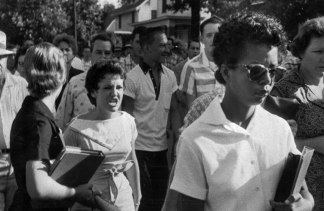A 2016 GAO report announced: The promise of Brown v. Board of Education is unraveling.
Residential resegregation is also a primary cause of increased health risks among people of color because of persistent racial disparities in exposure to environmental toxins. Minorities are more likely to be exposed to sulfate, a powerful respiratory irritant, and nickel, a possible carcinogen.
A 2014 University of Minnesota study showed that people of color are exposed to almost 50 percent more hazardous pollutants. Such communities, for example, inhale 46 percent more nitrogen dioxide, a pollutant linked to increased heart disease, lung cancer, asthma and premature births. It is one of six “criteria pollutants” that the Environmental Protection Agency regulates under the Clean Air Act.
Racial resegregation in U.S public schools is also deepening. A 2016 Government Accountability Office report announced: The promise of Brown v. Board of Education is unraveling.
The proportion of high-poverty, majority black and Latino schools has soared since 2001, according to the GAO study. The number of black and Latino students enrolled in resource-poor K-12 public schools — where 75 percent to 100 percent of students qualify for price-reduced lunch — increased 11 percent from 2001 to 2014.
In part, this is a product of what is known as school secession, acommon practice by which wealthy white communities around the country choose to “break away from their public-school districts to form smaller, more exclusive ones.” According to Nikole Hannah-Jones, a staff writer for The New York Times Magazine, “school secessions, at least in the South, trace their roots to the arsenal of tools white communities deployed to resist the desegregation mandate of the Brown ruling.”

In addition, the residue of historical segregation practices combined with creeping resegregation has created substantial disparities in wealth accumulation between people of color and white people. A legacy of racial bias and white supremacy in public policy, for example, blocked many black World War II veterans from receiving mortgage benefits under the GI bill. That prevented them from buying real estate, accruing home equity and bequeathing their estates to successive generations.
Moreover, as the New York Times reporters John Eligon and Robert Gebeloff noted in 2016: “Even when black households try to cross color boundaries, they are not always met with open arms: Studies have shown that white people prefer to live in communities where there are fewer black people, regardless of their income.”
This “preference” can have severe consequences. “The median white family held 13 times as much net wealth as the median black family” in 2013, according to the Federal Reserve’s 2017 Survey of Consumer Finances, “and 10 times as much wealth as the median Latino family. Just a decade earlier, the disparity was 7 to 1 for black families and 9 to 1 for Latino families.”
Indeed, the U.S. racial wealth gap remains largely attributable to public policy decisions driven by resegregation. Demos, a progressive think tank, explains this gap as a product of “the continuing impact of redlining on American home ownership to the retreat from desegregation in public education.”
Though public debate now focuses on racial inequality, this is not a particularly useful discussion. We need to jettison the vocabulary of racial inequality and instead focus on racial resegregation. Not only does the idiom of racial resegregation help remove the notion of “whiteness” as the reference point on which formal equality is measured, it also guards against the stigmatizing “culture of poverty” behavioral arguments that many conservatives routinely marshal.
“The current state of the American city is the direct result of unconstitutional, state-sanctioned racial discrimination.”
Infuriatingly, we’ve known about the deleterious effects of racial segregation for decades. In the aftermath of nationwide civil unrest — including the 1965 Watts Rebellion, triggered by racially biased policing practices, as well as 1967 uprisings in Detroit, Michigan and Newark, New Jersey — President Lyndon B. Johnson charged a panel of civic leaders with investigating the genesis of racial inequities in the United States. The Kerner Commission, chaired by Illinois Gov. Otto Kerner, released a chilling report.
“Our nation is moving toward two societies,” the report stated, “one black, one white — separate and unequal.” It concluded, “Equality cannot be achieved under conditions of nearly complete separation.”
Fast forward five decades, however, and this unequal separation continues to exist. Such “conditions” are, of course, not happenstance but rather the result of policies that have systematically favored the social well-being of white people at the expense of people of color.
In a recent interview, Richard Rothstein, author of “The Color of Law: A Forgotten History of How Our Government Segregated America,” discussed “the long history of federal, state and local policies that generated the residential segregation found across the country today.” He laid out the nation’s many racially biased policies, from the first segregated public housing built under President Franklin D. Roosevelt’s Federal Housing Administration and its mortgage underwriting program, to the 1949 Housing Act that encouraged white flight to the suburbs, to redlining — the unconstitutional racial zoning ordinances passed by city governments that became popular throughout the middle of the 20th century.
“The current state of the American city,” Rothstein said, “is the direct result of unconstitutional, state-sanctioned racial discrimination.”
Today, the very practices that the Kerner Commission pilloried back in 1968 are proliferating anew. If our nation really is committed to ensuring that racial segregation is relegated to the dustbin of history, we must focus on racial justice. Understanding that today’s inequalities and disparities have their roots in state-sponsored segregation — and are exacerbated by increasing resegregation — represents a crucial step in the right direction.
Christopher Petrella is a lecturer in American cultural studies at Bates College, who focuses on the cultural politics of race. He is writing a book on the history of white supremacy in 20th-century New England.



0 responses on "Christopher PetrellaThe resegregation of America"